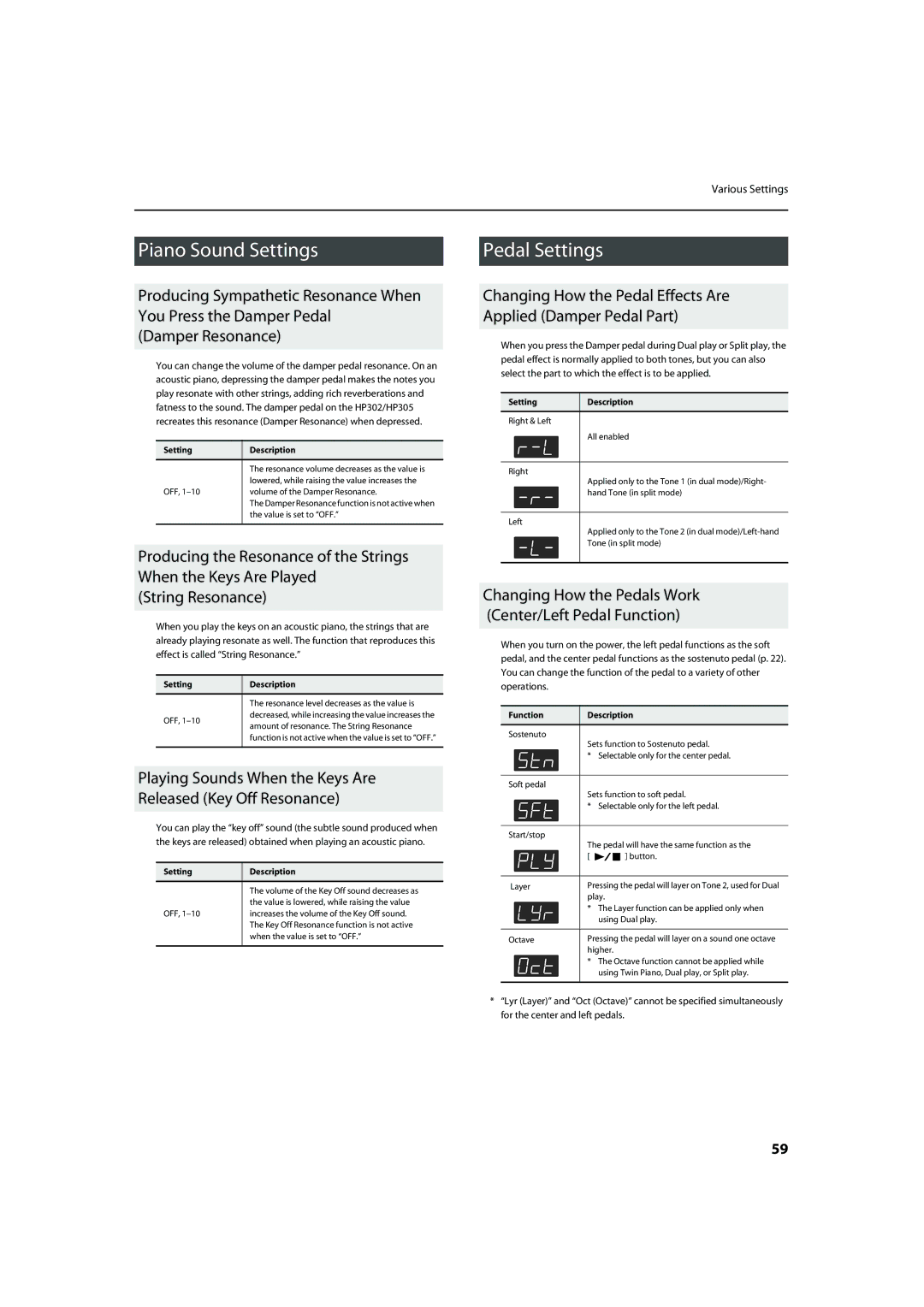
Various Settings
Piano Sound Settings
Producing Sympathetic Resonance When
You Press the Damper Pedal
(Damper Resonance)
You can change the volume of the damper pedal resonance. On an acoustic piano, depressing the damper pedal makes the notes you play resonate with other strings, adding rich reverberations and fatness to the sound. The damper pedal on the HP302/HP305 recreates this resonance (Damper Resonance) when depressed.
Setting | Description |
|
|
| The resonance volume decreases as the value is |
| lowered, while raising the value increases the |
OFF, | volume of the Damper Resonance. |
| The Damper Resonance function is not active when |
| the value is set to “OFF.” |
|
|
Producing the Resonance of the Strings
When the Keys Are Played
(String Resonance)
When you play the keys on an acoustic piano, the strings that are already playing resonate as well. The function that reproduces this effect is called “String Resonance.”
Setting | Description | |
|
| |
| The resonance level decreases as the value is | |
OFF, | decreased, while increasing the value increases the | |
amount of resonance. The String Resonance | ||
| ||
| function is not active when the value is set to “OFF.” | |
|
|
Playing Sounds When the Keys Are Released (Key Off Resonance)
You can play the “key off” sound (the subtle sound produced when the keys are released) obtained when playing an acoustic piano.
.
Setting | Description |
|
|
| The volume of the Key Off sound decreases as |
| the value is lowered, while raising the value |
OFF, | increases the volume of the Key Off sound. |
| The Key Off Resonance function is not active |
| when the value is set to “OFF.” |
|
|
Pedal Settings
Changing How the Pedal Effects Are Applied (Damper Pedal Part)
When you press the Damper pedal during Dual play or Split play, the pedal effect is normally applied to both tones, but you can also select the part to which the effect is to be applied.
Setting | Description |
|
|
Right & Left
All enabled
Right
Applied only to the Tone 1 (in dual mode)/Right- hand Tone (in split mode)
Left
Applied only to the Tone 2 (in dual
Changing How the Pedals Work (Center/Left Pedal Function)
When you turn on the power, the left pedal functions as the soft pedal, and the center pedal functions as the sostenuto pedal (p. 22). You can change the function of the pedal to a variety of other operations.
Function | Description |
|
|
Sostenuto
Sets function to Sostenuto pedal.
* Selectable only for the center pedal.
Soft pedal
Sets function to soft pedal.
* Selectable only for the left pedal.
Start/stop |
|
|
|
| |
|
| The pedal will have the same function as the | |||
|
| [ |
|
| ] button. |
|
|
|
| ||
|
|
|
|
|
|
|
|
|
|
|
|
Layer | Pressing the pedal will layer on Tone 2, used for Dual | ||||
|
| play. | |||
|
| * The Layer function can be applied only when | |||
|
|
| using Dual play. | ||
|
|
|
|
|
|
Octave | Pressing the pedal will layer on a sound one octave | ||||
|
| higher. | |||
|
| * The Octave function cannot be applied while | |||
|
|
| using Twin Piano, Dual play, or Split play. | ||
*“Lyr (Layer)” and “Oct (Octave)” cannot be specified simultaneously for the center and left pedals.
59
